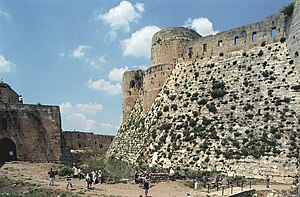Loading AI tools
Sloped base portion of a fortified wall From Wikipedia, the free encyclopedia
In architecture, the talus is a feature of some late medieval castles, especially prevalent in crusader constructions. It consists of a battered (sloping) face at the base of a fortified wall.
This article needs additional citations for verification. (February 2022) |
 The Krak des Chevaliers in Syria, with a tall and clearly defined talus |
The slope acts as an effective defensive measure in two ways. First, conventional siege equipment is less effective against a wall with a talus. Scaling ladders may be unable to reach the top of the walls and are also more easily broken due to the bending stresses caused by the angle they are forced to adopt. Siege towers cannot approach closer than the base of the talus, and their gangplank may be unable to cover the horizontal span of the talus, rendering them useless. Furthermore, defenders are able to drop rocks over the walls, which will shatter on the talus, spraying a hail of shrapnel into any attackers massed at the base of the wall.[1]
 The walls of the citadel of Tughlaqabad Fort in Delhi, India. The walls and towers are reinforced with a solid talus. |
Seamless Wikipedia browsing. On steroids.
Every time you click a link to Wikipedia, Wiktionary or Wikiquote in your browser's search results, it will show the modern Wikiwand interface.
Wikiwand extension is a five stars, simple, with minimum permission required to keep your browsing private, safe and transparent.